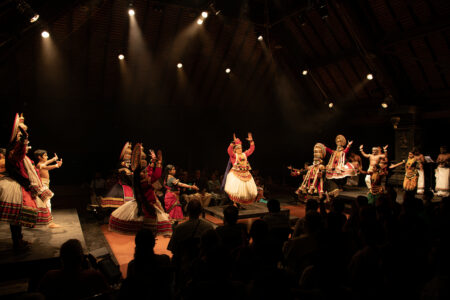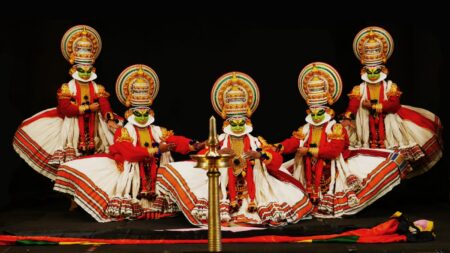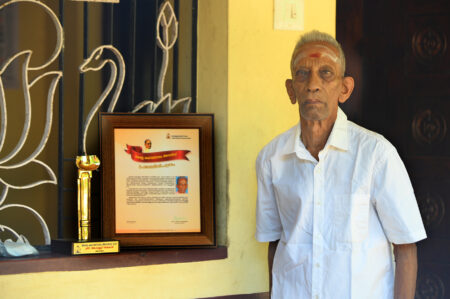At the time when performing arts was a no-no for an orthodox Christian family-born girl, Mary John overcame the obstacles, learned chutti and became the first Indian female chutti artist.
The twentieth century witnessed sea changes in the dance-theatre of Kathakali. While women in large numbers gate-crashed on to the stage of the art form, Mary John had a different option. She preferred to be in the dim-lit aniyara (green room) where human beings are transformed into ethereal characters that appear on the stage. Trained by the veteran master Kalamandalam Ram Mohan, Mary graduated into the first Indian female chuttikkari (make-up artiste) thereby making history.
Performing arts of any kind, especially Kathakali for that matter, was taboo for the girl who was born in a Christian orthodox family in Piravam, a suburb of Kochi. But supported by her brother she managed to watch stealthily performances going on around the village. Gradually she developed a passion for classical dances and Kathakali. At home, she tried to imitate some feats which attracted severe punishments from the parents.
A turning point in her life occurred in 1982 when her family shifted to Vaniyamkulam in the Palakkad district. She had completed her SSLC that year. “Fortunately for me the marriage proposal from the Kathakali artiste Kalamandalam John was not objected to by my parents”, remembered Mary presently in the US teaching in her own institution there. She was in cloud nine when John wanted her to practice classical dances. But there was intervention by her parents again. Interestingly they were won over since John wanted her to learn chutti which did not require any performance on the stage. “It was a ploy to hoodwink my parents because along with chutti lessons, I was also taking lessons in dance secretly” revealed Mary.
Her first chutti
Chutti was an art entirely strange to Mary but in three years Ram Mohan moulded her talents to the hilt. Colours are prepared with indigenous ingredients and their application on the face of the artiste necessitates maximum care. With his blessings, her debut took place after the successful completion of the course. Mary could not hide her excitement when asked as to who was the first artiste for whom she had done chutti – John, her husband! But surprisingly this was in Italy in 1989 when she donned up John as Bhīma and his Italian disciple Beppe Karicatti as Panchali in Kalyanasougandhikam.
She never had to look back since then. The feedback from the Kathakali fraternity was inspiring. Opportunities unfolded and she could make-up a long array of veterans including Kalamandalam Ramankutty Nair, Kottakkal Krishnankutty Nair, Kottakkal Sivaraman, Kalamandalam Padmanabhan Nair, Sadanam Krishnankutty, Kalamandalam Rajasekharan et al. There have been occasions when she had to accomplish as many as five different veshams for a play. Mary averred that while all the veshams had become handy for her, vella thaadi (white beard) usually employed for Hanuman was a hard nut to crack because this demanded much finesse.
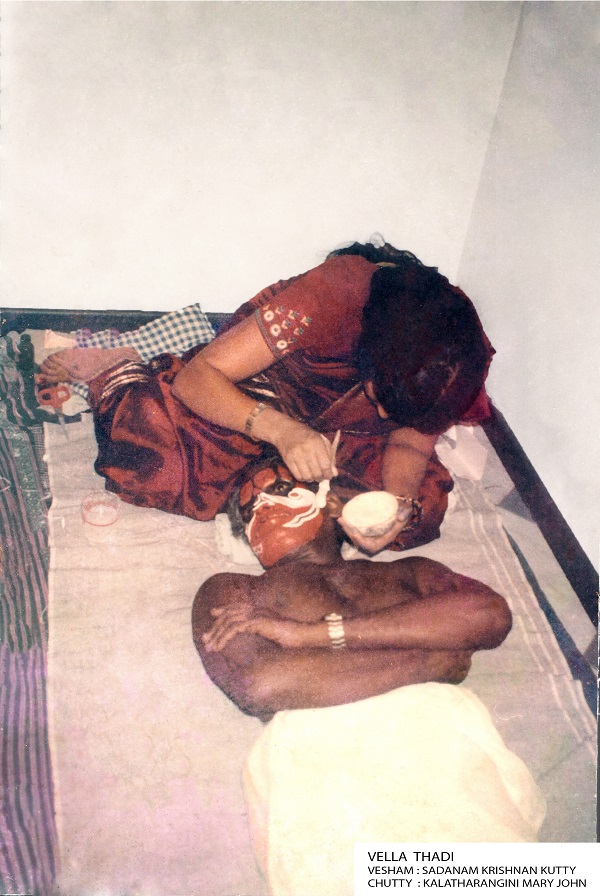
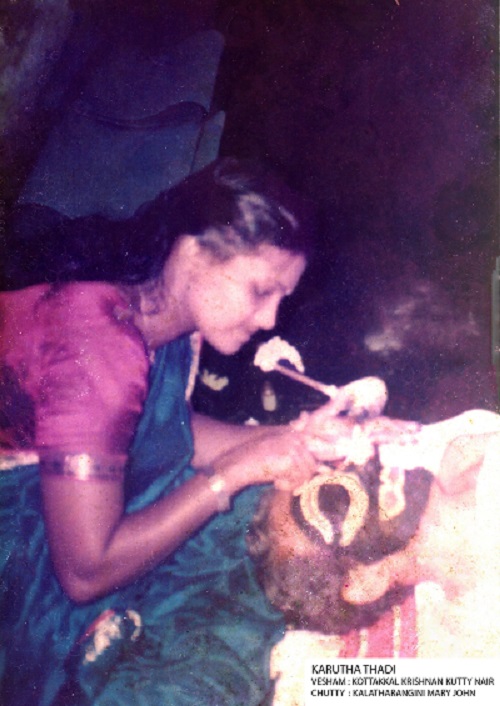
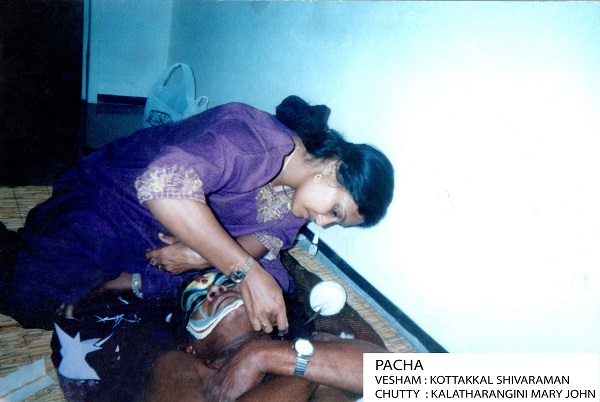
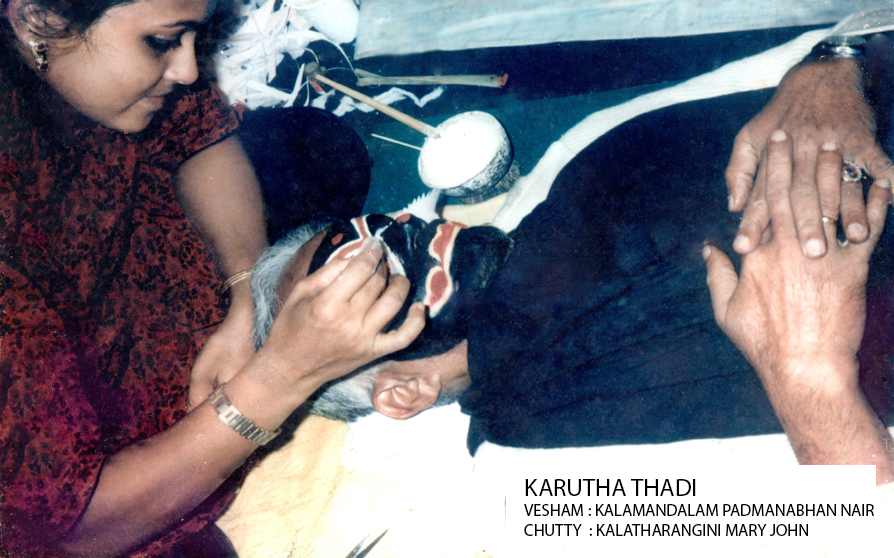
Ram Mohan took care to train his disciple in all departments of aniyara so that she could be in total control of the space. Stitching of costumes, decoration of the headgear, holding thiraseela (curtain) and all such concomitant jobs could be single-handled by her. She was also the first woman to hold thiraseela for the thiranokku (curtain look) of many major characters portrayed by senior artistes. Fortunately for her, a full set of costumes was given as a gift by Mohanlal after the shoot of the film Vanaprastham.
Versatile artist
Mary was of immense help to her husband who had established his own Kathakali training institute in Cheruthuruthy, Kalatharangini. Winner of the A D Boland Gold Medal in 1977, a much-coveted award for the student who secured the first rank in Kathakali vesham, John’s ambition was to be a teacher in Kalamandalam. Though he served his alma mater temporarily for a few years, a permanent post eluded him owing to many reasons. Kalatharangini sprang into existence out of this disenchantment. Today, John cannot count the number of foreigners who had been trained by him in Kalatharangini. In all the foreign tours, more than a spouse Mary was the sole make-up artiste.
Over the years, Mary was trained in the classical dances Mohiniyattam, Bharatanatyam and Kuchipudi under the doyens and turned into an accomplished performer and guru as well. Moreover, she has classes in almost all countries in Europe apart from the US. Many are the students who are trained regularly in chutti and a good number of them are fashion-designers.
While amateur women artistes enamoured by the flamboyant costumes and archaic jewellery continue to take to vesham (performance) in large numbers, Mary chooses to be in the aniyara, the sanctum of Durga, the patron deity of Kathakali, whose invisible presence is the chief source of her inspiration.


